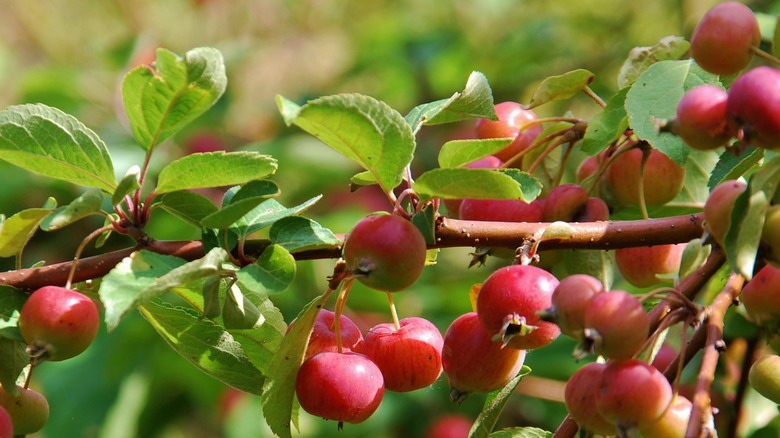Each year my crabapple seems to lose its leaves earlier and earlier. They develop spots, turn yellow and soon drop. What can I do? .
Apple scab is a fungal disease that causes the problem you describe. It is a common problem on crabapples. Many of the newer varieties have been bred to be resistant to this and the deadly fireblight disease, which is good news. Using a fungicide when the flower buds start to turn color and then every 10 to 14 days for a total of 4 or 5 times is usually enough to keep susceptible types under control. This tree should be replaced with a disease-resistant crabapple. This will save you work in the long run and be better for the environment.
It can be alarming when the leaves on your crab apple tree start turning yellow and dropping. But with the right troubleshooting, you can get your tree back to its healthy vibrant state. In this article, we’ll explore the most common reasons for yellowing crab apple foliage along with tips to restore your tree’s luster.
What Causes Crab Apple Leaves to Turn Yellow?
There are several potential culprits that can cause crab apple tree leaves to become yellow and fall off. Here are some of the most likely reasons:
-
Old age – As crab apple trees mature, their leaves naturally start to yellow and drop in fall. This is normal, but rapid yellowing may indicate other issues.
-
Overwatering – Too much moisture around the roots deprives them of oxygen, causing yellow, wilting foliage.
-
Underwatering – Drought stress also yellows and shrivels leaves as the tree struggles for moisture.
-
Overfertilization – Excess salts from too much fertilizer accumulates and burns leaf tissues
-
Insufficient sunlight – Without adequate sunlight (at least 6 hours daily), leaves yellow from deficiency of light energy.
-
Extreme weather – Heat, cold, hail and high winds place stress on trees, resulting in yellowing leaves.
-
Transplant shock – Recently transplanted trees often show yellowing if roots are damaged and unable to supply water/nutrients.
-
Pests – Spider mites, aphids, scale and other insects feed on leaves, causing yellow spots, distortion and wilt.
-
Diseases – Bacterial and fungal diseases manifest through leaf yellowing, spots and premature dropping.
Solutions for Yellow Crab Apple Tree Leaves
If your crab apple tree has yellow, spotty or dropping leaves, follow these tips to get it healthy again:
-
Check soil moisture – Test the soil around the roots and adjust watering so it’s moist but not saturated.
-
Fertilize carefully – Avoid over-fertilizing and follow label directions. Do a soil test to ensure proper nutrient levels.
-
Increase sunlight – If possible, prune or trim nearby trees and structures that are shading the crab apple tree.
-
Protect from weather – Wrap or cover the tree in extreme cold or heat. Stake trees in windy areas to avoid strain on roots.
-
Treat transplant shock – Water newly planted trees regularly and avoid disturbing the roots until established.
-
Control pests – Apply horticultural oils or insecticidal soaps at first signs of infestation before damage spreads.
-
Manage diseases – Remove and destroy infected leaves/branches. Apply fungicides as needed after inspection.
-
Add mulch – A 2-3 inch organic mulch layer helps maintain soil moisture and temperature.
-
Prune judiciously – Prune out dead or damaged branches but avoid heavy pruning that stresses trees.
Preventing Yellowed Crab Apple Tree Leaves
With proper care and maintenance, you can avoid many of the issues that cause crab apple leaf yellowing:
-
Select resistant varieties – Choose disease-resistant crab apple tree cultivars less prone to pest and disease problems.
-
Practice good sanitation – Rake and dispose of fallen leaves/debris to remove overwintering sites for fungal spores and insects.
-
Water moderately – Avoid both overwatering and underwatering. Irrigate slowly and deeply in morning.
-
Fertilize minimally – Crab apples don’t require much extra feeding. Test soil before applying balanced organic fertilizer.
-
Promote air circulation – Thin interior branches and avoid crowding other plants too closely to allow air flow.
-
Check for signs of stress – Routinely inspect trees for early symptoms of pest/disease issues before they intensify.
-
Protect from weather extremes – Provide young or vulnerable trees with covers or support structures during harsh weather as needed.
With attentive care, issues causing yellow crab apple foliage can be reduced or avoided altogether. But even mature, hardy trees need monitoring to stay in top form. By identifying and addressing problems early, you can keep your crab apple tree happy and colorful through every season.
Upcoming Live Events & Webinars
August 1-11, 2024 Wisconsin State Fair West Allis, WI 2024 Energy Park Gardens info Sept. 5, 2024 Year-round Perennial Garden Maintenance Wauwatosa Public Library Wauwatosa, WI Sept. 7, 2024 Fall Planting for a Beautiful Landscape Pasquesi Home & Gardens Lake Bluff, IL Sept. 11, 2024 Art en Fleurs Milwaukee, WI Sept. 12, 2024 WEBINAR: Fall Landscape Planting and Care Register here Sept. 21, 2024 Preparing Your Garden for Winter Eberts Greenhouse Village Ixonia, WI WATCH ON-DEMAND WEBINARS Learn More.
Help Me! My Crabapple & Peach Trees Are Sick | Brown, Wilty Leaves | How to Treat Them | Food Forest
FAQ
How do you treat a sick crabapple tree?
What does a diseased crabapple tree look like?
Why are the leaves on my apple tree turning yellow?
Do crabapple trees need a lot of water?
- The Ultimate Guide to Growing Strawberries in Raised Beds - August 8, 2025
- No-Dig Garden Beds: The Easiest Way to Grow a Beautiful Garden - August 6, 2025
- How to Protect and Preserve Wood for Raised Garden Beds - August 6, 2025

